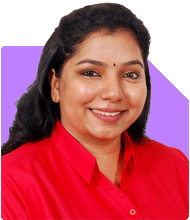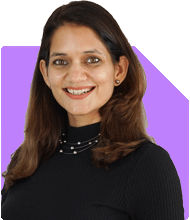56-Year-Old with Knee Pain Due to Cancer: How to Start Yoga as a Beginner?
Pushpa R |65 Answers |Ask -Follow
Yoga, Mindfulness Expert - Answered on Nov 25, 2024
In the last 10 years, she has trained over 400 people in yoga and counselled many others at corporate events.
She holds a master of science degree in yoga for human excellence from Bharathidasan University, Trichy.
Pushpa specialises in meditation, yoga for wellness and mindfulness.... more

Im 56 when i sit in floor. Cant get up. Two hands support on bed and then get up. 84 kgs slim . I cant reduce complications will arise bcoz cancer pt. Now i want t switch t yoga a beginer. Pls suggest
As a beginner, I recommend starting with simple seated or lying-down poses like Sukhasana (Easy Pose), Balasana (Child’s Pose), and Shavasana (Relaxation Pose). Breathing exercises like Anulom Vilom (Alternate Nostril Breathing) can also help improve energy levels and calm your mind.
Since you have health complications, it’s best to learn yoga under the guidance of an experienced yoga coach. A coach will guide you on which poses are safe and beneficial for your condition. Practicing alone without proper instructions may lead to strain or injury.
Yoga is not just exercise; it’s a journey towards better physical and mental health. Start slowly, listen to your body, and take one step at a time. You will gradually notice improvements in your strength and confidence.
If you need guidance, I’m here to help you start your yoga journey safely.
R. Pushpa, M.Sc (Yoga)
Online Yoga & Meditation Coach
Radiant YogaVibes
https://www.instagram.com/pushpa_radiantyogavibes/
You may like to see similar questions and answers below
Namita Piparaiya | Answer |Ask -Follow
Yoga, Wellness Expert - Answered on Apr 12, 2023
Radhika Iyer | Answer |Ask -Follow
Yoga Expert - Answered on Jun 20, 2023
Radhika Iyer | Answer |Ask -Follow
Yoga Expert - Answered on Jun 21, 2023
Radhika Iyer | Answer |Ask -Follow
Yoga Expert - Answered on Sep 24, 2024
Pushpa R |65 Answers |Ask -Follow
Yoga, Mindfulness Expert - Answered on Oct 23, 2024
Nayagam P P |10446 Answers |Ask -Follow
Career Counsellor - Answered on Aug 21, 2025
Nayagam P P |10446 Answers |Ask -Follow
Career Counsellor - Answered on Aug 21, 2025
Nayagam P P |10446 Answers |Ask -Follow
Career Counsellor - Answered on Aug 21, 2025
Nayagam P P |10446 Answers |Ask -Follow
Career Counsellor - Answered on Aug 21, 2025
Nayagam P P |10446 Answers |Ask -Follow
Career Counsellor - Answered on Aug 21, 2025
Nayagam P P |10446 Answers |Ask -Follow
Career Counsellor - Answered on Aug 21, 2025
Nayagam P P |10446 Answers |Ask -Follow
Career Counsellor - Answered on Aug 21, 2025
Nayagam P P |10446 Answers |Ask -Follow
Career Counsellor - Answered on Aug 21, 2025
Nayagam P P |10446 Answers |Ask -Follow
Career Counsellor - Answered on Aug 21, 2025
Nayagam P P |10446 Answers |Ask -Follow
Career Counsellor - Answered on Aug 21, 2025





















